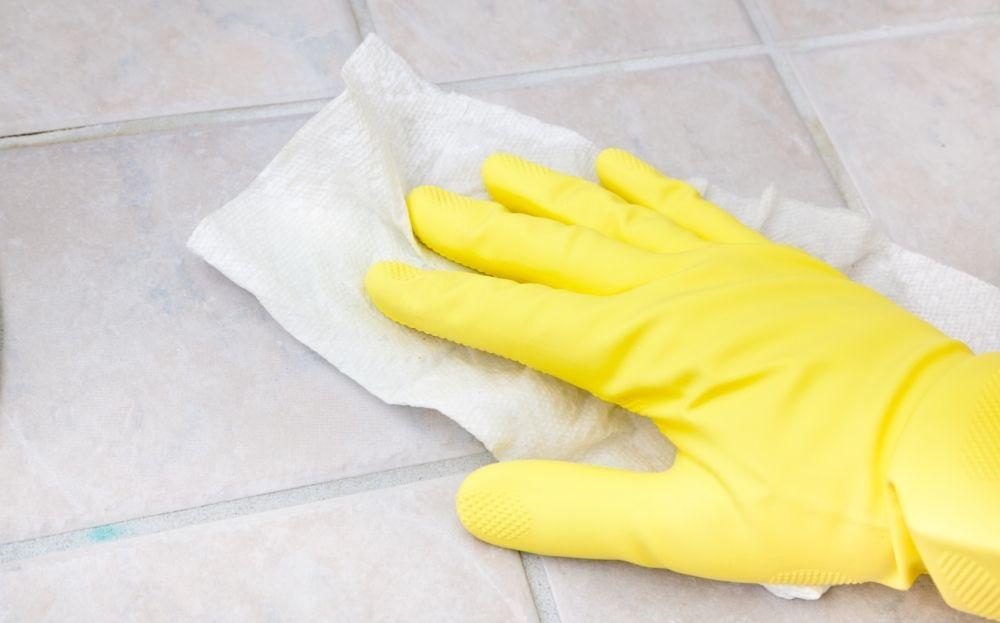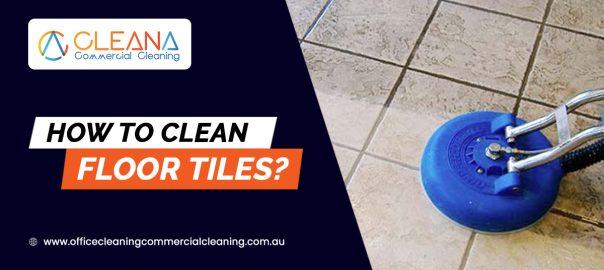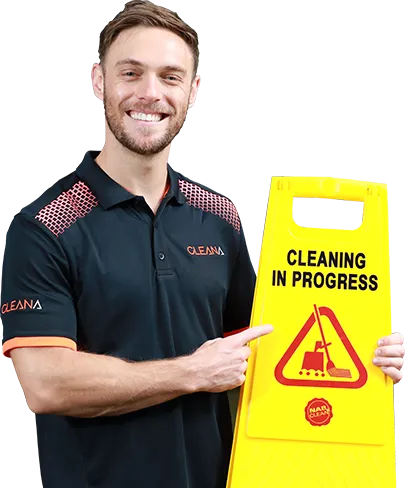You can usually find tiled floors in kitchens and bathrooms, and they can be stunning. The big problem with tiled floors is the cleaning, though. Although they can come in any colour and pattern you could want, when it is time to clean them, most of us are not sure where to start.
Chances are, you can see dirt and grime stuck between each tile, but what are you supposed to use to get it looking brand new?
If you need to clean the tiles in your house or know someone who does, you have come to the right place where Cleana’s professional commercial cleaners share the best way to clean different types of tile floors.
These types include ceramic and porcelain, resilient tiles (like rubber, vinyl, cork, and rubber), and stone. We will also cover how to clean groups effectively so that your tiled rooms will look pristine.
How To Tell When Your Tiles Are Dirty
Noticing when your tile floors are dirty is pretty easy – they will become visibly discoloured. There might be dark or light spots, or a slippery layer. If the tiles look dirty, they probably are dirty, so it is time to clean them.
Cleaning Resilient Tiles
The way you clean resilient tiles will change with every type of tile, but they are all extremely easy to clean and maintain. Plus, resilient tiles are very durable, as their name suggests. So, if you want tiles that will last a lifetime, consider getting these.
As a general rule, you should never use steam on resilient tiles. They are not good options for places or methods that use a lot of moisture. Similarly, extreme heat does not work well with these tiles. So, although breaking out the steam mop might seem like the easiest option, it will not do your tiles any favours.
- Cork Tiles – How you clean your cork tiles will depend on what finish they have. While most cork tiles are sealed with polyurethane, some are not. If your tiles are sealed, clean them using water with a mild detergent mixed in, or white vinegar. Once cleaned, rinse them well, and then they are good to go. If your tiles are not sealed, you will need to carefully follow the instructions for polyurethane. Once they are clean, you will need to apply wax to the floor once it is dry. This wax can be solid or liquid, it is up to you.
- Linoleum Tiles – Linoleum flooring requires Borax detergent or a specialized linoleum cleaning solution. Before using any solution, you will need to vacuum or sweep the floor thoroughly. Once this is done, wash the floors with a mop, or, if you like, a cloth. You will have to allow the floor to dry and then once dry, apply a solid or liquid wax coat, and buff to shine. Linoleum floors should only have to be buffed once every 3-6 months to keep them in pristine condition.
- Vinyl Tiles – Vinyl is super easy and attractive tiles to have in the home. To clean them, all you have to do is vacuum or sweep the floor to get rid of any debris, then mop. You can use water and vinegar or a vinyl cleaning solution, but both work well. For these floors, you must never scrub them or use an abrasive cleaner, as you will damage the tile by scratching the surface it.
How To Clean Ceramic And Porcelain Tiles

The best method for cleaning ceramic tiles is the same for porcelain, so this one is really easy. To clean these types of tiled floors, all you need to do is:
- Sweep or vacuum up any debris that might be lying on the floor – you should be sweeping or vacuuming your tile frequently so that they always look shiny and new. Leaving debris like grit or sand on them can cause the tiles’ glazed surfaces to dull and lost that sparkle.
- Use a chamois-style mop instead of a sponge one – chamois-style mops are the best option for cleaning tiles as they do not push dirty water into the grout likes.
- Use a mild detergent and change the mop water regularly – using a mild detergent does a wonderful job on these kinds of floors, so there is no need to go in with the heavy-duty stuff. While mopping, be sure to frequently change the mop water you are using to make sure you are not inadvertently dirtying the floor as you mop.
- Be careful of stains on the tiles – not all stains are made equal, and some are way easier to remove than others. As you mop, look out for stains and determine where they are from. Once you have an idea of what caused them, use the corresponding cleaning product to remove them. If you take wild guesses, you could get there trying to get a stain out all day, when all you need is the correct solution.
- Soap residue – if you have finished mopping and your tiles look hazy or cloudy, there might be soap residue. To get your floors shining again, use a non-abrasive all-purpose cleaner, or you can use a homemade solution like lemon juice!
- Remember to dry the tiles – if you leave your glazed tiles to air dry, the water on them will form spots and undo all that cleaning you just did. After washing the floor, immediately begin drying it with a lint-free cloth that is clean. The best way to do this is by using your foot to slide the cloth around.
Getting Your Stone Floors Looking New
Natural stone floors are beautiful and will take your breath away, but you need to be careful with them. Floor tiles made out of marble, slate, or granite require some special attention if you want them to look their best.
It is always best to avoid using chemicals for these floors, as the chemicals can cause damage. Using cleaning products that have been specifically designed for each type of stone floor will be the wise option.
- Granite Tiles – tiles made of granite need to be cleaned with a pH-neutral, mild detergent. If you make the mistake of using a detergent with harsh chemicals in it, you risk discolouring the tile and leaving is covered in streaks. To keep granite floors looking clean and shiny, buff them.
- Slate Tiles – any mild detergent that does not have acidic properties will work well on slate tiles. Even things like lemon and vinegar can be damaging to these floors, so be careful. After cleaning these floors, always dry the tiles immediately so that you can avoid water spots.
- Marble Tiles – although arguably the most beautiful, marble tiles require a lot of maintenance. You need to avoid detergents with acidic pH levels, and using lemon or vinegar is a no-go. Anything remotely acidic can have a damaging effect on the stunning finish. Additionally, when washing marble tiles with mild detergents, never use anything that could scratch them, such as scouring powders or brushes.
Cleaning Tile Grout
Your tiles can be as clean as can be, and your floors can still look a mess. Grout can many any tiled floor look like it has not been cleaned in years, so learning how to effectively clean it is crucial. If your grout looks like it could do with a pick-me-up, there are some easy steps to take to help it look its best.
- Grout cleaner – you can buy a commercial grout cleaner or, even better, make your own at home! You can mix water and baking soda together to make a paste to use as your grout cleaner.
- Scrub, scrub, scrub – palace the paste you made (or bought) anywhere that looks like it is stained and rub it in. Leave it to sit overnight, and in the morning you can get scrubbing. Use a stiff nylon brush rather than a metal one, as the metal will damage the grout, and keep scrubbing. Getting the group to look clean again could take some time, so be prepared to have some patience. It will be worth it in the end.
- Seal it – once the grout is sufficiently cleaned, apply a silicone-based sealer. This will reduce the likeliness of future stains occurring. Applying a sealer will work best when the tiled floors are new (10-14 days old), or the grout is renewed but can work well enough if you did not have the chance to do it before.
The Truth: How Regularly Should You Clean Your Tile Floors?
Keeping our floors clean can be a lot of work, but only when you do not stay on top of the cleaning. The best option is to find a middle ground and do regular cleaning.
Once a week, the floors should be swept or vacuumed. If you can see dust and debris on the floors before that, then clean it! Use a vacuum with a soft-bristle attachment or a hand broom with a dustpan to keep floors looking great.
Every two weeks, your tiled floors around the house should be mopped. If your tiled floors are in the bathroom, it is best to clean them weekly since there is often a fast build-up of germs.
Every few months, the grout around your house may need to be cleaned. Keep an eye on the group and clean it when required.
Final Thoughts On Cleaning Tiled Floors
Cleaning tiles can be very easy when done right, and you will be rewarded with stunning and durable floors. As long as you stay on top of your cleaning routine, things will never get too out of hand.
By following the instructions given in this post, you should now know how to take care of your tiled floors and what you should and should not do. If you are ever in doubt about anything, it is always best to read up on it first.
You do not want to be putting lemon juice on marble, and that would be a very expensive mistake to make.

